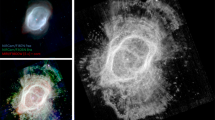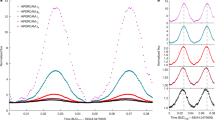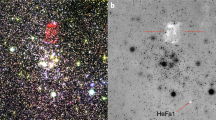Abstract
Preplanetary nebulae and planetary nebulae are evolved, mass-losing stellar objects that show a wide variety of morphologies. Many of these nebulae consist of outer structures that are nearly spherical (spiral/shell/arc/halo) and inner structures that are highly asymmetric (bipolar/multipolar)1,2. The coexistence of such geometrically distinct structures is enigmatic because it hints at the simultaneous presence of both wide and close binary interactions, a phenomenon that has been attributed to stellar binary systems with eccentric orbits3. Here, we report high-resolution molecular line observations of the circumstellar spiral-shell pattern of AFGL 3068, an asymptotic giant branch star transitioning to the preplanetary nebula phase. The observations clearly reveal that the dynamics of the mass loss is influenced by the presence of an eccentric-orbit binary. This quintessential object opens a window on the nature of deeply embedded binary stars through the circumstellar spiral-shell patterns that reside at distances of several thousand au from the stars.
This is a preview of subscription content, access via your institution
Access options
Access Nature and 54 other Nature Portfolio journals
Get Nature+, our best-value online-access subscription
$29.99 / 30 days
cancel any time
Subscribe to this journal
Receive 12 digital issues and online access to articles
$119.00 per year
only $9.92 per issue
Buy this article
- Purchase on Springer Link
- Instant access to full article PDF
Prices may be subject to local taxes which are calculated during checkout



Similar content being viewed by others
References
Balick, B. & Frank, A. Shapes and shaping of planetary nebulae. Annu. Rev. Astron. Astrophys. 40, 439–486 (2002).
Sahai, R., Morris, M. R. & Villar, G. G. Young planetary nebulae: Hubble Space Telescope imaging and a new morphological classification system. Astron. J. 141, 134 (2011).
Kim, H. et al. High-resolution CO observation of the carbon star CIT 6 revealing the spiral structure and a nascent bipolar outflow. Astrophys. J. 814, 61 (2015).
Morris, M. et al. A binary-induced pinwheel outflow from the extreme carbon star, AFGL 3068. In Planetary Nebulae in our Galaxy and Beyond, Proc. International Astronomical Union Symp. No. 234 (eds Barlow, M. J. & Méndez, R. H. ) 469–470 (Cambridge Univ. Press, 2006).
Mauron, N. & Huggins, P. J. Imaging the circumstellar envelopes of AGB stars. Astron. Astrophys. 452, 257–268 (2006).
Soker, N. Influences of wide binaries on the structures of planetary nebulae. Mon. Not. R. Astron. Soc. 270, 774–780 (1994).
Mastrodemos, N. & Morris, M. Bipolar pre-planetary nebulae: hydrodynamics of dusty winds in binary systems. II. Morphology of the circumstellar envelopes. Astrophys. J. 523, 357–380 (1999).
Kim, H. & Taam, R. E. Wide binary effects on asymmetries in asymptotic giant branch circumstellar envelopes. Astrophys. J. 759, 59 (2012).
Kim, H. & Taam, R. E. A new method of determining the characteristics of evolved binary systems revealed in the observed circumstellar patterns: application to AFGL 3068. Astrophys. J. Lett. 759, L22 (2012).
Kim, H., Hsieh, I.-T., Liu, S.-Y. & Taam, R. E. Evidence of a binary-induced spiral from an incomplete ring pattern of CIT 6. Astrophys. J. 776, 86 (2013).
Cernicharo, J., Marcelino, N., Agúndez, M. & Guélin, M. Molecular shells in IRC+10216: tracing the mass loss history. Astron. Astrophys. 575, A91 (2015).
Soker, N. in Asymmetrical Planetary Nebulae III: Winds, Structure and the Thunderbird (eds Meixner, M., Kastner, J. H., Balick, B. & Soker, N. ) 562–568 (Astron. Soc. Pacif. Conf. Ser. Vol. 313, 2004).
Soker, N. Why magnetic fields cannot be the main agent shaping planetary nebulae. Publ. Astron. Soc. Pacif. 118, 260–269 (2006).
Bond, H. E. in Asymmetrical Planetary Nebulae II: From Origins to Microstructures (eds Kastner, J. H., Soker, N. & Rappaport, S. ) 115–123 (Astron. Soc. Pacif. Conf. Ser. Vol. 199, 2000).
Miszalski, B., Acker, A., Moffat, A. F. J., Parker, Q. A. & Udalski, A. Binary planetary nebulae nuclei towards the Galactic bulge. I. Sample discovery, period distribution, and binary fraction. Astron. Astrophys. 496, 813–825 (2009).
Douchin, D. et al. The binary fraction of planetary nebula central stars — II. A larger sample and improved technique for the infrared excess search. Mon. Not. R. Astron. Soc. 448, 3132–3155 (2015).
Sahai, R., Findeisen, K., Gil de Paz, A. & Sánchez Contreras, C. Binarity in cool asymptotic giant branch stars: a GALEX search for ultraviolet excesses. Astrophys. J. 689, 1274–1278 (2008).
Morris, M. Models for the structure and origin of bipolar nebulae. Astrophys. J. 249, 572–585 (1981).
Su, K. Y. L. in Asymmetrical Planetary Nebulae III: Winds, Structure and the Thunderbird (eds Meixner, M., Kastner, J. H., Balick, B. & Soker, N. ) 247–253 (Astron. Soc. Pacif. Conf. Ser. Vol. 313, 2004).
Corradi, R. L. M., Sánchez-Blázquez, P., Mellema, G., Giammanco, C. & Schwarz, H. E. Rings in the haloes of planetary nebulae. Astron. Astrophys. 417, 637–646 (2004).
Ramos-Larios, G. et al. Rings and arcs around evolved stars — I. Fingerprints of the last gasps in the formation process of planetary nebulae. Mon. Not. R. Astron. Soc. 462, 610–635 (2016).
Sahai, R., Scibelli, S. & Morris, M. R. High-speed bullet ejections during the AGB-to-planetary nebula transition: HST observations of the carbon star, V Hydrae. Astrophys. J. 827, 92 (2016).
Huarte-Espinosa, M., Carroll-Nellenback, J., Nordhaus, J., Frank, A. & Blackman, E. G. The formation and evolution of wind-capture discs in binary systems. Mon. Not. R. Astron. Soc. 433, 295–306 (2013).
Verbunt, F. & Phinney, E. S. Tidal circularization and the eccentricity of binaries containing giant stars. Astron. Astrophys. 296, 709–721 (1995).
Maercker, M. et al. Unexpectedly large mass loss during the thermal pulse cycle of the red giant star R Sculptoris. Nature 490, 232–234 (2012).
Claussen, M. J. et al. A pilot imaging line survey of RW LMi and IK Tau using the Expanded Very Large Array. Astrophys. J. Lett. 739, L5 (2011).
Ramstedt, S. et al. The wonderful complexity of the Mira AB system. Astron. Astrophys. 570, L14 (2014).
Decin, L. et al. ALMA data suggest the presence of spiral structure in the inner wind of CW Leonis. Astron. Astrophys. 574, A5 (2015).
Raga, A. C., Cantó, J., Esquivel, A., Huggins, P. J. & Mauron, N. in Asymmetric Planetary Nebulae V (eds Zijlstra, A. A., Lykou, F., McDonald, I . & Lagadec, E. ) 185–191 (Jodrell Bank Centre for Astrophysics, 2011).
Tuthill, P. G., Monnier, J. D. & Danchi, W. C. A dusty pinwheel nebula around the massive star WR104. Nature 398, 487–489 (1999).
McMullin, J. P., Waters, B., Schiebel, D., Young, W. & Golap, K. in Astronomical Data Analysis Software and Systems XVI (eds Shaw, R. A., Hill, F. & Bell, D. J. ) 127–130 (Astron. Soc. Pacif. Conf. Ser. Vol. 376, 2007).
Pearson, T. J. & Readhead, A. C. S. Image formation by self-calibration in radio astronomy. Annu. Rev. Astron. Astrophys. 22, 97–130 (1984).
Fryxell, B. et al. FLASH: an adaptive mesh hydrodynamics code for modeling astrophysical thermonuclear flashes. Astrophys. J. Suppl. Ser. 131, 273–334 (2000).
Colella, P. & Woodward, P. R. The piecewise parabolic method (PPM) for gas-dynamical simulations. J. Comput. Phys. 54, 174–201 (1984).
Acknowledgements
This paper makes use of the following ALMA data: ADS/JAO.ALMA#2013.1.00179.S. ALMA is a partnership of the European Southern Observatory (representing its member states), the National Science Foundation (USA) and the National Institutes of Natural Sciences (Japan), together with the National Research Council (Canada), the National Science Council and Academia Sinica Institute of Astronomy and Astrophysics (Taiwan), and Korea Astronomy (Taiwan), Space Science Institute (Republic of Korea), in cooperation with the Republic of Chile. The Joint ALMA Observatory is operated by the European Southern Observatory, Associated Universities, Inc. National Radio Astronomy Observatory and the National Astronomical Observatory of Japan. H.K. acknowledges support through the East Asian Core Observatories Association Fellowship, and thanks F. Kemper for encouraging the project and reviewing an early version of the manuscript. R.S.’s contribution to this research was carried out at the Jet Propulsion Laboratory, California Institute of Technology, under a contract with NASA, with financial support in part from a NASA/STScI HST award (GO 11676.02).
Author information
Authors and Affiliations
Contributions
H.K. planned the project, prepared and submitted the proposal, and wrote the manuscript. A.T. was involved in observation preparation, data reduction and analysis, and commented on the manuscript. S.-Y.L. was involved in project planning, data interpretation, and manuscript preparation. R.S., R.E.T., M.R.M. and N.H. were involved in the science discussion as well as writing the proposal and manuscript. I.-T.H. did the radiative transfer modelling in the proposal preparation that generated the data for this study.
Corresponding author
Ethics declarations
Competing interests
The authors declare no competing financial interests.
Supplementary information
Supplementary Information
Supplementary Figures 1–4 and Supplementary Video 1 caption. (PDF 1889 kb)
Supplementary Information
Supplementary Video 1 (GIF 6547 kb)
Rights and permissions
About this article
Cite this article
Kim, H., Trejo, A., Liu, SY. et al. The large-scale nebular pattern of a superwind binary in an eccentric orbit. Nat Astron 1, 0060 (2017). https://doi.org/10.1038/s41550-017-0060
Received:
Accepted:
Published:
DOI: https://doi.org/10.1038/s41550-017-0060
This article is cited by
-
Chemical tracers of a highly eccentric AGB–main-sequence star binary
Nature Astronomy (2024)
-
Reduction of the maximum mass-loss rate of OH/IR stars due to unnoticed binary interaction
Nature Astronomy (2019)
-
Mass loss of stars on the asymptotic giant branch
The Astronomy and Astrophysics Review (2018)
-
Binary stars as the key to understanding planetary nebulae
Nature Astronomy (2017)



